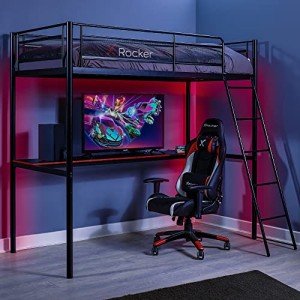10 Fundamentals Regarding Bunk Beds You Didn't Learn In School
페이지 정보

본문

Exploring Bunk Beds: A Comprehensive Guide
Bunk beds have long been a staple in children's bed rooms, dorms, and even homes with minimal space. Not only do they offer a useful sleeping option, but they also create a fun and creative environment for children and a great space-saver for adults and households. This post will explore everything you require to understand about bunk beds, from types and materials to security pointers and purchasing advice.
Table of Contents
- Types of Bunk Beds
- Traditional Bunk Beds
- Loft Beds
- Triple Bunk Beds
- L-Shaped Bunk Beds
- Product Options
- Wood
- Metal
- Safety Considerations
- Buying Guide
- FAQs
Types of Bunk Beds
Bunk beds come in numerous styles to fit various needs and preferences. Here's a breakdown of the most typical types:
Conventional Bunk Beds
Traditional bunks typically feature two beds stacked vertically on top of one another. These beds are perfect for siblings sharing a space or for optimizing sleeping space in guest spaces.
Loft Beds
Loft beds stand similarly to traditional bunk beds however do not have a lower sleeping location. Rather, they typically incorporate a desk or seating location underneath, making them a great choice for little spaces requiring multifunctionality.
Triple Bunk Beds
Triple bunk beds are created for 3 occupants, with beds stacked in a three-tier configuration. These are less typical however can be an enjoyable solution for big families or sleepovers.
L-Shaped Bunk Beds
With one bed positioned horizontally and the other vertically, L-shaped bunk beds are typically geared up with extra features such as desks or storage drawers and can match corner areas in a space.
Contrast of Bunk Bed Types
| Bed Type | Suitable Use | Description |
|---|---|---|
| Conventional | Shared bedrooms or visitor spaces | Two beds stacked vertically |
| Loft | Small spaces needing multi-purpose space | Upper bed with open space below |
| Triple | Big households or sleepovers | 3 beds stacked vertically |
| L-Shaped | Corner or versatile areas | A combination of vertical and horizontal beds |
Product Options
Bunk beds are produced from numerous products, with wood and metal being the most typical. Each material has its benefits and drawbacks.
Wood
- Resilience: Generally robust and can hold up against years of usage.
- Aesthetic Appeal: Offers a classic look that can blend with various designs.
- Weight Capacity: Typically sturdier; can support much heavier weights.
- Drawbacks: May be more costly than metal options and can be prone to scratches.
Metal
- Toughness: Generally light-weight and easy to move but still durable.
- Modern Design: Often can be found in sleek styles, making it appealing for modern spaces.
- Cost-Effective: Usually cheaper than wooden choices.
- Drawbacks: Can be cold to the touch in winter seasons and might not have the exact same aesthetic appeal for some buyers.
Security Considerations
When it comes to bunk beds, safety can not be overlooked. Here are essential safety ideas to keep in mind:
- Guardrails: Ensure that the leading bunk has guardrails on both sides to avoid falls.
- Durable Construction: Check for a strong construct and tough products to endure weight and movement.
- Weight Limit: Adhere to the maker's weight limitation for both the upper and lower bunks.
- Ladder Design: Choose bunks with a safe, easy-to-climb ladder and avoid any sharp edges or rungs.
- Age Restrictions: Most manufacturers suggest that children under the age of 6 must not sleep in the upper bunk.
Purchasing Guide
When looking for bunk beds, consider the list below elements to discover the very best suitable for your needs:
- Space Availability: Measure the space size and ceiling height, guaranteeing there is adequate space for the top bunk.
- Bed Size: Decide in between twin, complete, or larger sizes based upon your requirements and the size of the space saving bunk Beds.
- Design Preference: Consider the overall design of the bedroom to discover a suitable style.
- Alleviate of Setup: Look for a bunk bed that is uncomplicated to assemble.
- Spending plan: Bunk beds come in various cost varieties, so determine a budget before starting your search.
Frequently asked questions
1. What is the advised age for children to sleep on the top bunk?
Children aged 6 and older are normally suggested to sleep on the top bunk to reduce the threat of falls.
2. How can I make my bunk bed safer?
To improve safety, make sure guardrails are correctly installed and inspect that the bed is put on a flat surface area. In addition, motivate kids to utilize the ladder carefully.
3. Can I transform a bunk bed into 2 separate beds?
Numerous bunk beds are designed to be convertible. Check the manufacturer's requirements for convertibility features.
4. What accessories are readily available for bunk beds?
Typical accessories include bed linens, storage drawers, staircases rather of ladders, and tented canopies for a fun visual appeal.
5. How do I maintain my bunk bed?
Routine look for loose screws or structural stability can help ensure safety. Dust the bed frequently and tidy spills promptly to keep the products in good condition.
Bunk beds are versatile and a space-efficient service for different living situations, from children's spaces to visitor lodgings. With numerous styles and materials readily available, possible purchasers have a wealth of alternatives to consider, guaranteeing a mix of practicality and aesthetics. By focusing on security and following the tips detailed in this guide, people can find the ideal bunk bed that matches their space and way of life, all while creating a satisfying sleeping environment.
- 이전글При этом принуждение на сильфоне падает 25.06.18
- 다음글Специализируюсь удивительно через своим морозильниками! 25.06.18
댓글목록
등록된 댓글이 없습니다.
![정국토건[주]](http://jkst.co.kr/img/ci.svg)

![정국토건[주]](http://jkst.co.kr/img/ci_bt.svg)